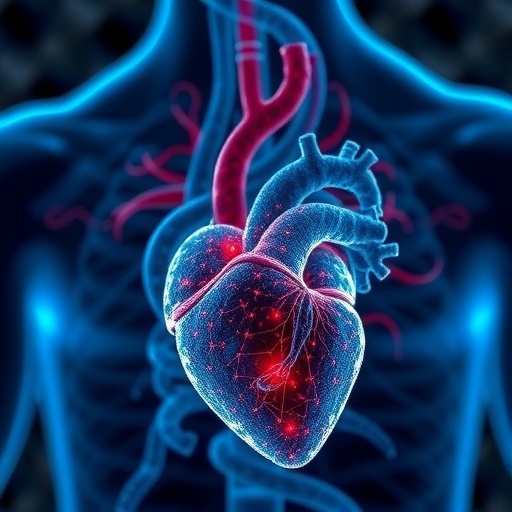In a groundbreaking new study published in Nature Communications, scientists have unveiled a comprehensive cross-study transcriptional patient map of heart failure that delineates the conserved multicellular coordination underlying cardiac remodeling. This pioneering research sheds unprecedented light on the intricate cellular choreography that governs the progression of heart failure, a global health crisis affecting millions of individuals worldwide. By harnessing integrative transcriptomic analyses from diverse patient cohorts, the study pioneers a novel framework for understanding the molecular and cellular basis of the devastating remodeling process in failing hearts.
Heart failure remains a leading cause of morbidity and mortality despite advances in medical therapy and device interventions, largely due to the complex and heterogeneous nature of cardiac remodeling. This remodeling involves maladaptive changes in cardiomyocytes, fibroblasts, endothelial cells, and infiltrating immune populations that collectively degrade cardiac structure and function. Previous studies have focused predominantly on isolated cell populations or animal models, limiting comprehensive insight into human disease pathobiology. However, the newly released transcriptional map synergizes data across multiple independent investigations, providing an unprecedented, high-resolution portrait of the multicellular interactions that drive progression in human heart failure.
The research team employed cutting-edge single-cell RNA sequencing and integrative bioinformatics approaches to amalgamate datasets from patients suffering different forms of heart failure, including ischemic and dilated cardiomyopathies. This cross-study integration enabled the construction of a transcriptional atlas that characterizes distinct cellular phenotypes and intercellular communication networks conserved across patient populations. Such conservation points toward universal remodeling mechanisms that transcend etiological differences, highlighting potential targets for therapeutic intervention.
A key finding of the study is the identification of conserved fibroblast activation signatures implicating these cells as central orchestrators of pathological extracellular matrix remodeling. Fibroblasts, traditionally viewed merely as structural components, are shown to adopt pro-fibrotic transcriptional programs that drive scar formation and stiffening of the myocardium. These insights redefine the role of fibroblasts from passive matrix producers to active participants in disease progression through dynamic crosstalk with cardiomyocytes and immune cells.
Simultaneously, the study elucidates alterations in endothelial cell signaling pathways that contribute to impaired angiogenesis and microvascular rarefaction in failing hearts. Disruptions in vascular homeostasis exacerbate ischemia and fuel chronic inflammation, compounding tissue damage. The multiparametric transcriptional data reveal specific ligand-receptor interactions that modulate endothelial responses, offering avenues to restore microvascular integrity therapeutically.
Immune cell subsets featured prominently in the transcriptional atlas, unveiling a conserved inflammatory milieu characterized by distinct macrophage and T cell populations that perpetuate cardiac injury and fibrosis. By dissecting the immune landscape at single-cell resolution, the research delineates pro-inflammatory and reparative subtypes, illuminating their divergent roles across remodeling stages. This nuanced understanding of immune involvement paves the way for precision immunomodulatory strategies in heart failure management.
Moreover, the cross-study integration strategy employed in this research illustrates the power of aggregating heterogeneous patient datasets to overcome limitations of individual cohort studies. By applying rigorous normalization and batch effect correction algorithms, the team harmonized molecular profiles, enhancing signal detection and reproducibility. This methodological framework sets a new standard for future multi-omic investigations in cardiovascular disease and beyond.
The study also highlights the importance of cellular plasticity in cardiac remodeling, showcasing how cardiomyocytes and non-myocyte populations dynamically shift their transcriptomic states in response to chronic stress. These transient phenotypic changes underscore the potential reversibility of maladaptive remodeling if the underlying molecular drivers are effectively targeted. This insight infuses new optimism into the quest for curative therapies.
Through spatial transcriptomics and computational modeling, the researchers reconstructed the spatial arrangement and interaction networks of cell populations within the diseased myocardium. This spatial context elucidates microenvironmental niches where pathological signaling is amplified, facilitating localized therapeutic targeting. Such spatially-resolved data represent a significant advance over traditional bulk tissue analyses that mask cellular heterogeneity.
The translational potential of these findings is substantial. By pinpointing conserved transcriptional programs and intercellular signaling axes central to heart failure pathology, this comprehensive map provides a rich resource for drug discovery. Pharmaceutical efforts can now prioritize molecular targets validated across diverse patient cohorts, enhancing the likelihood of successful clinical outcomes.
The authors also emphasize the implications for patient stratification and personalized medicine. This multicellular transcriptional map could serve as a blueprint for developing biomarker panels that reflect underlying pathophysiological processes, enabling tailored therapeutic regimens that address individual remodeling phenotypes. Precision cardiology stands to benefit immensely.
Importantly, this study catalyzes further research into the temporal dynamics of remodeling by offering a stable reference atlas for longitudinal investigations. Understanding how cellular states and communication networks evolve from early heart stress to end-stage failure will inform the timing and combination of interventions to halt or reverse disease progression.
Looking forward, integrating additional omics layers, such as proteomics and epigenomics, with this transcriptional framework could yield even deeper mechanistic insight. The intersection of multi-omic data modalities promises to unravel complex regulatory hierarchies and identify master regulators of remodeling.
The cross-disciplinary collaboration exemplified by this study, blending clinical science, molecular biology, computational genomics, and systems biology, highlights the future pathway of cardiovascular research. Such integrative approaches are essential to decode the multifactorial nature of heart failure and to innovate effective treatments.
In conclusion, this cross-study transcriptional patient map marks a monumental leap in decoding the multicellular architecture and coordination driving cardiac remodeling in heart failure. By exposing conserved molecular and cellular mechanisms, it lays the groundwork for transformative advances in diagnosis, therapeutics, and personalized patient care in this pervasive and deadly disease.
Subject of Research: Heart failure; transcriptional profiling; multicellular coordination; cardiac remodeling; single-cell RNA sequencing.
Article Title: A cross-study transcriptional patient map of heart failure defines conserved multicellular coordination in cardiac remodeling.
Article References:
Lanzer, J.D., Ramirez Flores, R.O., Liñares Blanco, J. et al. A cross-study transcriptional patient map of heart failure defines conserved multicellular coordination in cardiac remodeling. Nat Commun 16, 9659 (2025). https://doi.org/10.1038/s41467-025-62219-6
Image Credits: AI Generated




